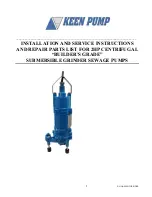
3
P/N O&M-BG2GRINDER
Read all instructions in this manual before operating pump.
Most accidents can be avoided by using COMMON SENSE.
Please read this before installing or operating pump. This
information is provided for
SAFETY
and to
PREVENT
EQUIPMENT PROBLEMS.
To help recognize this information,
observe the following symbols:
IMPORTANT!
Warns about hazards that can
Result in personal injury or indicates factors
concerned with assembly, installation,
operation, or maintenance which could result
in damage to the machine or equipment if
ignored.
CAUTION!
Warns about hazards that can or will cause minor
personal injury or property damage if ignored. Used with
symbols below.
WARNING!
Warns about hazards that can or will cause
personal injury, death, or major property damage if ignored.
Used with symbols below.
Hazardous fluids can
Extremely hot - Severe
cause fire or explos- burns can occur on
Ions, burns or death contact.
could result.
Biohazard can cause
Hazardous fluids -
Serious personal injury.
Pressure, eruptions or
Explosions could cause
Rotating machinery.
Injury or property damage.
Amputation or severe
laceration can result.
Hazardous voltage can
shock, burn or cause death.
Only qualified personnel should install, operate and repair pump.
Any wiring of pump should be performed by a qualified
electrician.
WARNING!
To reduce risk of electrical shock, pumps
and control panels must be properly grounded in
accordance with the National Electric Code (NEC) or the
Canadian Electrical Code (CAC) and all applicable state,
province, local codes and ordinances.
WARNING!
To reduce risk of electrical shock, always
disconnect the pump from power source before
handling or servicing. Lock out power and tag.
Prevent large articles of clothing, large amounts of chemicals,
other materials or substances such as are uncommon in
domestic sewage from entering the system.
During power black-outs, minimize water consumption at the
home(s) to prevent sewage from backing up into house.
Always keep the shut-off valve completely open when system is
in operation (unless advised otherwise by proper authorities).
Before removing pump from basin, be certain to close shut-off
valve. (This prevents backflow from pressure sewer).
Keep control panel locked or confined to prevent unauthorized
access.
If pump is idle for long periods of time, it is advisable to start
pump occasionally by adding water to basin.
CAUTION!
Pumps build up heat and pressure
during operation
– allow time for pumps to cool
before handling or servicing.
WARNING! DO NOT
pump hazardous materials
(flammable, caustic, etc.) unless pump is specifically
designed and designated to handle.
Do not block or restrict discharge hose/pipe, as hose/pipe may
“whip” under pressure.
WARNING! DO NOT
wear loose clothing which may
become entangled in impeller or other moving parts.
WARNING!
Keep clear of suction and discharge
openings.
DO NOT
insert fingers in pump with power
connected.
Make sure lift handles are securely fastened each time before
lifting. Do not operate pump without safety devices in place.
Always replace safety devices that have been removed during
service or repair.
Do not exceed manufacturer’s recommendation for maximum
performance, as this could cause motor to overheat.
Secure pump in its operating position so it does not tip over, fall
or slide.
Cable should be protected at all times to avoid punctures, cut,
bruises and abrasions
– inspect frequently.
Never handle connected power cords with wet hands.
To reduce risk of electrical shock, all wiring and
junction connections should be made per NEC or
CEC and applicable state or province and local codes.
Requirements may vary depending on usage and
location.
Submersible pumps are
NOT APPROVED
for use in
swimming pools, recreational water installations,
decorative fountains or any installation where human
contact with the pumped fluid is common.
Do not remove cord and strain relief. Do not connect conduit to
pump.
Products returned must be cleaned, sanitized, or
decontaminated as necessary prior to shipment. To
insure that employees will not be exposed to health
hazards in handling said material, all applicable laws
and regulations shall apply.
Bronze/brass and bronze/brass fitted pumps may contain lead
levels higher than considered safe for potable water systems.
Various government agencies have determined that leaded
copper alloys should not be used in potable water applications.






























